Le sacre du printemps premieres in Paris
29 May 1913
 Well I've gone way back in time for this, but what a great place to start this greatest cultural moments timeline for the century, in Paris with a Russian ballet! This great work (Le sacre du printemps, aka The Rite of Spring or Весна священная) was a collaboration of four men: music by Igor Stravinsky (Игорь Фёдорович Стравинский, 1882-1971), choreography by Vaslav Nijinsky (Ва́цлав Фоми́ч Нижи́нский, 1889-1950), set design and costumes by Nicholas Roerich (Никола́й Константи́нович Рéрих, 1874-1947), production by Sergei Diaghilev (Серге́й Па́влович Дя́гилев, 1872-1929) for his Ballets Russes. These were some of the greatest artistic minds of the century. The ballet premiered in Paris on 29 May 1913, and from surviving accounts it is clear that the audience was upset (a riot was narrowly averted) and had no idea what was happening on the stage. The ballet was so much different than other "classical" ballet productions of the time.
Well I've gone way back in time for this, but what a great place to start this greatest cultural moments timeline for the century, in Paris with a Russian ballet! This great work (Le sacre du printemps, aka The Rite of Spring or Весна священная) was a collaboration of four men: music by Igor Stravinsky (Игорь Фёдорович Стравинский, 1882-1971), choreography by Vaslav Nijinsky (Ва́цлав Фоми́ч Нижи́нский, 1889-1950), set design and costumes by Nicholas Roerich (Никола́й Константи́нович Рéрих, 1874-1947), production by Sergei Diaghilev (Серге́й Па́влович Дя́гилев, 1872-1929) for his Ballets Russes. These were some of the greatest artistic minds of the century. The ballet premiered in Paris on 29 May 1913, and from surviving accounts it is clear that the audience was upset (a riot was narrowly averted) and had no idea what was happening on the stage. The ballet was so much different than other "classical" ballet productions of the time.The opening bassoon solo is followed by discordant sounds coming from all kinds of instruments (playing loudly) and from all kinds of different angles--Stravinsky used a very large orchestra. To a 1913 audience it must have sounded as if the orchestra was just warming up! When was the music really going to start? But it had already begun. When the dancers appear on stage in sack cloths, hopping about, the audience wondered, Where was the beautiful figure of the ballerina dancing across the stage?
The ballet divides into two acts. The first part is the L'adoration de la Terre (the worship of the earth); followed by the second part Le Sacrifice (no translation needed). The first part is mostly just young girls dancing around on stage in preparation for the sacrifice to the nature god which will follow. At some point in act one, the mythical father Christmas figure appears on stage (see below). The second part is the sacrifice, and through most of the act, the prima ballerina just stands quivering, little dancing. You might wonder, where is the greatness in all of this?
This music ushered in the twentieth century. The power and frantic nature of the music and the dancing so very much expressed the age of the modern city (even though the ballet was hearkening back to a natural past thousands of years ago and an imagined age of early Slavic earth goddesses). That's the enduring paradox of the ballet (the past and modern intertwined; even though we think that we are modern, we are really still prehistoric). Another aspect symbolic of the modern age is the crush of dancers on the stage (think of the crush of people in the modern city) and the relative less prominent role for the prima ballerina (the individual of today), who stands there shaking, a sacrifice to a new age, a sacrifice that she is helpless to avoid.
Well, life was changing in the early twentieth century, and the ballet captured the essence of that change by invoking the imagery of a prehistoric Slavic past. In one dance, everyone on stage is banging on the floor--many people have that similar feeling about life today--and that was something the 1913 audience did not understand; why the banging? What did it all mean?
I have watched this many times now and still cannot figure out much of it, for example, the Father Frost figure, and I think that the ballet still challenges audiences today, which is why it is not performed that often. It does not provide clear answers. Stravinsky and his collaborators ended up capturing the absurd survival of myth and misperception at the start of the century, the weirdness of what lay ahead. The ballet is not all that long. Take an hour, watch and enjoy.
 Who could have known at the time that a story about the relationship between a man and a bug would end up being one of the greatest cultural achievements of the century? Probably very few people. I think that it would be very interesting to know how many people actually bought the book when it appeared in the middle of World War I. I don't think that it made any top 50 lists.
Who could have known at the time that a story about the relationship between a man and a bug would end up being one of the greatest cultural achievements of the century? Probably very few people. I think that it would be very interesting to know how many people actually bought the book when it appeared in the middle of World War I. I don't think that it made any top 50 lists.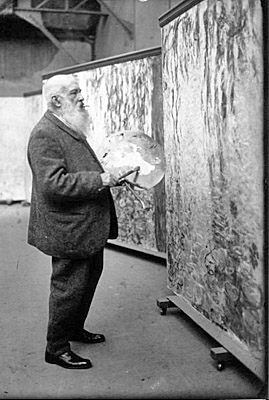 Claude Monet (1840-1926) was one of France's greatest painters and one of the originators of the art movement that came to be termed impressionism (named after his painting "Impression, soleil levant" aka "Impression Sunrise" from 1872). From the 1880s onwards Monet lived and painted in his workshop at Giverny on the River Seine about an hour north of Paris. Most of his paintings from that time until his death focused on depictions of the water lilies that he cultivated in his gardens. There are hundreds of these paintings (some of the most expensive works ever auctioned in the art world), but the most famous are the eight huge canvases of Les Nymphéas that are on display in the Musée de l'Orangerie in Paris.
Claude Monet (1840-1926) was one of France's greatest painters and one of the originators of the art movement that came to be termed impressionism (named after his painting "Impression, soleil levant" aka "Impression Sunrise" from 1872). From the 1880s onwards Monet lived and painted in his workshop at Giverny on the River Seine about an hour north of Paris. Most of his paintings from that time until his death focused on depictions of the water lilies that he cultivated in his gardens. There are hundreds of these paintings (some of the most expensive works ever auctioned in the art world), but the most famous are the eight huge canvases of Les Nymphéas that are on display in the Musée de l'Orangerie in Paris. In 1930 Lewis Milestone (1895-1980) released his movie version of Erich Maria Remarque's book, Im Westen nichts Neues (All Quiet on the Western Front), which was first published in late 1928 (and in book form in early 1929). This was a book that was a best seller! It is interesting to read the controversy surrounding the changes that were made to the first American book edition (the deletion of some episodes). I'd also like to point out that the book was a book-of-the-month selection. Anyway back to the movie.
In 1930 Lewis Milestone (1895-1980) released his movie version of Erich Maria Remarque's book, Im Westen nichts Neues (All Quiet on the Western Front), which was first published in late 1928 (and in book form in early 1929). This was a book that was a best seller! It is interesting to read the controversy surrounding the changes that were made to the first American book edition (the deletion of some episodes). I'd also like to point out that the book was a book-of-the-month selection. Anyway back to the movie.  Well, a movie version of the book has finally been produced. Part 1 premiered in December 2012, but here I'd like to focus on the book, since I am assuming that everyone will love the movie. People will just sit there and watch the movie unfold on the big screen instead of reading the book and letting their minds wander into distant, imagery realms--that's a big difference. I am not sure how a movie will do justice to the imagery in the book. For example, I have received all kinds of feedback for criticizing the movie. In particular, I am still unsure about the movie's portrayal of the half-rabbit, half-something else hobbit creature--everyone keeps telling me that he isn't a rabbit. That is just one of the fantastic attractions of the book because every reader can imagine the characters in their own way, scary or not scary. Also, when reading the book you are never really sure when (past or present or future) it is set, and you are certainly not sure where the events take place.
Well, a movie version of the book has finally been produced. Part 1 premiered in December 2012, but here I'd like to focus on the book, since I am assuming that everyone will love the movie. People will just sit there and watch the movie unfold on the big screen instead of reading the book and letting their minds wander into distant, imagery realms--that's a big difference. I am not sure how a movie will do justice to the imagery in the book. For example, I have received all kinds of feedback for criticizing the movie. In particular, I am still unsure about the movie's portrayal of the half-rabbit, half-something else hobbit creature--everyone keeps telling me that he isn't a rabbit. That is just one of the fantastic attractions of the book because every reader can imagine the characters in their own way, scary or not scary. Also, when reading the book you are never really sure when (past or present or future) it is set, and you are certainly not sure where the events take place. 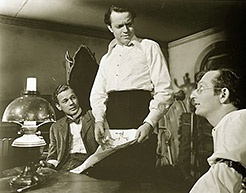
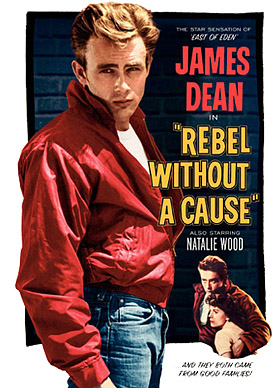 James Dean (1831-1955) appears on the big screen in a movie that tackles the angst of growing up in white suburbia in the 1950s, a time of supposed family values and general prosperity. Dean only made three films in his short life before dying in a car crash: Rebel without a Cause (1955), East of Eden (1955) and Giant (1956). They are great films, and Dean achieved iconic stature as a result of his roles in these three movies and his tragic early death.
James Dean (1831-1955) appears on the big screen in a movie that tackles the angst of growing up in white suburbia in the 1950s, a time of supposed family values and general prosperity. Dean only made three films in his short life before dying in a car crash: Rebel without a Cause (1955), East of Eden (1955) and Giant (1956). They are great films, and Dean achieved iconic stature as a result of his roles in these three movies and his tragic early death.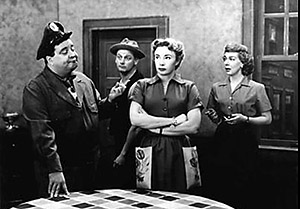
 Let's start with some details. This series was created by René Goscinny (writer, 1926-1977) and Albert Uderzo (illustrator, 1927-) with their first comic strip appearing in 1959, and eventually the first book in 1961 (Astérix le Gaulois). Other titles tended to appear roughly yearly after that. I first discovered these books when I was studying French in grad school; no longer sure about the exact year or the exact circumstances, but I was quickly hooked to follow the exploits of Astérix and his companion-in-arms Obélix as they struggle to resist the Roman legions (led by Caesar) in 50 BC: "Nous sommes en 50 avant Jésus-Christ ; toute la Gaule est occupée par les Romains… Toute ? Non ! Car un village peuplé d'irréductibles Gaulois résiste encore et toujours à l'envahisseur. Et la vie n'est pas facile pour les garnisons de légionnaires romains des camps retranchés de Babaorum, Aquarium, Laudanum et Petibonum… "
Let's start with some details. This series was created by René Goscinny (writer, 1926-1977) and Albert Uderzo (illustrator, 1927-) with their first comic strip appearing in 1959, and eventually the first book in 1961 (Astérix le Gaulois). Other titles tended to appear roughly yearly after that. I first discovered these books when I was studying French in grad school; no longer sure about the exact year or the exact circumstances, but I was quickly hooked to follow the exploits of Astérix and his companion-in-arms Obélix as they struggle to resist the Roman legions (led by Caesar) in 50 BC: "Nous sommes en 50 avant Jésus-Christ ; toute la Gaule est occupée par les Romains… Toute ? Non ! Car un village peuplé d'irréductibles Gaulois résiste encore et toujours à l'envahisseur. Et la vie n'est pas facile pour les garnisons de légionnaires romains des camps retranchés de Babaorum, Aquarium, Laudanum et Petibonum… "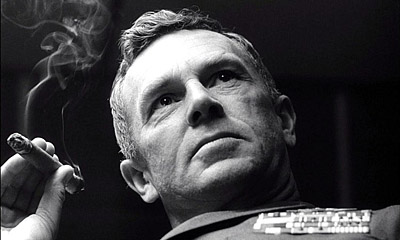 How dare someone make fun of the Cold War, and the US Air Force and the very basic premise of the Cold War, MAD--mutually assured destruction? How could you poke fun at the fact that millions of school kids practiced air raid drills every year, with their heads bowed between their knees while they sat huddled in school hallways? Wasn't this a dangerous time of the Cuban Missile Crisis and hydrogen and atom bombs? Wasn't the US Air Force and American military leadership the best in the world? Well, Stanley Kubrik did make fun of every thing connected with the Cold War in one of the most penetrating satires to ever air on the big screen. You can call it a black comedy, or gallows humor (being funny in the face of death); in reality it is simply one of the greatest movies ever made, and funny as all heck if you can catch the jokes.
How dare someone make fun of the Cold War, and the US Air Force and the very basic premise of the Cold War, MAD--mutually assured destruction? How could you poke fun at the fact that millions of school kids practiced air raid drills every year, with their heads bowed between their knees while they sat huddled in school hallways? Wasn't this a dangerous time of the Cuban Missile Crisis and hydrogen and atom bombs? Wasn't the US Air Force and American military leadership the best in the world? Well, Stanley Kubrik did make fun of every thing connected with the Cold War in one of the most penetrating satires to ever air on the big screen. You can call it a black comedy, or gallows humor (being funny in the face of death); in reality it is simply one of the greatest movies ever made, and funny as all heck if you can catch the jokes.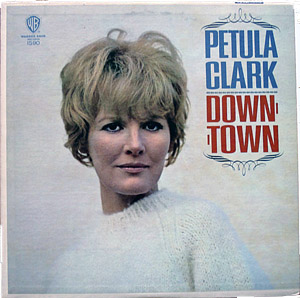 Well, you might wonder what is so darned remarkable about this song by a British pop artist from the mid-1960s. Quite simply, it is the earliest song that I can recall ever hearing on the radio. I was just in kindergarten at the time (morning sessions in the Lincoln school in Slatington; the room had these great big wooden play blocks, a lot of wooden puzzles, a play kitchen area--mostly for the girls--short wooden tables for about six kids to sit at, and we got a snack and a chance to take a nap!). Boy, that was really small town America.
Well, you might wonder what is so darned remarkable about this song by a British pop artist from the mid-1960s. Quite simply, it is the earliest song that I can recall ever hearing on the radio. I was just in kindergarten at the time (morning sessions in the Lincoln school in Slatington; the room had these great big wooden play blocks, a lot of wooden puzzles, a play kitchen area--mostly for the girls--short wooden tables for about six kids to sit at, and we got a snack and a chance to take a nap!). Boy, that was really small town America.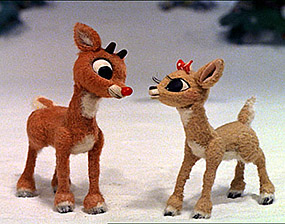
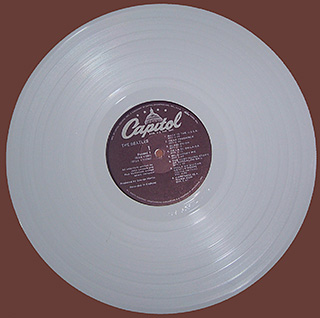 Released 22 November 1968, about fifteen months after the smash Sgt. Pepper's Lonely Hearts Club Band, this double album caught the Beatles at a different moment in time. Recorded in the summer of 1968, the band was in turmoil at the time, each member exploring different artistic directions, and rarely was the entire band in a recording session at the same time. Everyone's individual talents and focuses were at work, and most of the songs on the album were really the work of the Beatles as individuals. The variety of musical directions on the album is often considered one of the strengths of the album; there is so much that was experimental on here. As you listen, you will realize that there was no other music like this being produced on the rock and roll scene in 1968 (not much like it since that date either). This was the Beatles' first album for their own record company, Apple (consider the fact that they had become powerful and wealthy enough to set up their own record company). The new company added to the artistic tensions within the group. As I was thinking of which Beatles album to feature on this list, I thought of Revolver or Sgt. Pepper or even The Beatles at the Hollywood Bowl, a live album which I remember buying when it came out in May 1977--a real impression of what Beatlemania was all about. There is simply so much great (and bizarre) tunes on the White album: Birthday, Rocky Raccoon, Revolution 1, Helter Skelter, Revolution 9. Later Capitol released a special white vinyl pressing of the white album.
Released 22 November 1968, about fifteen months after the smash Sgt. Pepper's Lonely Hearts Club Band, this double album caught the Beatles at a different moment in time. Recorded in the summer of 1968, the band was in turmoil at the time, each member exploring different artistic directions, and rarely was the entire band in a recording session at the same time. Everyone's individual talents and focuses were at work, and most of the songs on the album were really the work of the Beatles as individuals. The variety of musical directions on the album is often considered one of the strengths of the album; there is so much that was experimental on here. As you listen, you will realize that there was no other music like this being produced on the rock and roll scene in 1968 (not much like it since that date either). This was the Beatles' first album for their own record company, Apple (consider the fact that they had become powerful and wealthy enough to set up their own record company). The new company added to the artistic tensions within the group. As I was thinking of which Beatles album to feature on this list, I thought of Revolver or Sgt. Pepper or even The Beatles at the Hollywood Bowl, a live album which I remember buying when it came out in May 1977--a real impression of what Beatlemania was all about. There is simply so much great (and bizarre) tunes on the White album: Birthday, Rocky Raccoon, Revolution 1, Helter Skelter, Revolution 9. Later Capitol released a special white vinyl pressing of the white album.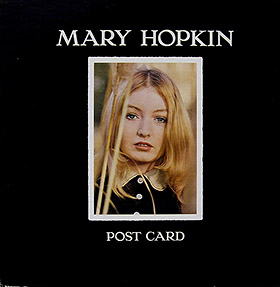 Well, after graduating from college in May 1982, I ended up working at Newport News Shipbuilding and Drydock Company and living in the Denbigh section of Newport News. A bunch of us usually car-pooled into work because of the traffic congestion. By that time, I already had a pretty substantial record collection (not mp3s, or DVDs, or CDs, or cassettes, or 8-track tapes, but good old records). These played on a Technics SL-1900 direct-drive turntable (still working in 2013), powered by a Technics SA-5000 (also still working) stereo receiver with Phillips speakers, but I digress. One day while browsing through the records in a used record store, I heard "Voyage of the Moon" sung by Mary Hopkin (written by Donovan). What a haunting song! I asked the owner of the store about the album, and I purchased it. The record also contained her hit single (Those Were the Days) and two other great songs, Prince en Avignon (sung in French) and Y Blodyn Gwyn (sung in Welsh--Mary was herself Welsh). The album was a very early Apple product (the Beatles' label at the time), and the record was produced by Paul McCartney himself. Hopkin kind of retired from recording after 1971, but did release songs on and off after that, and she has occasionally appeared on stage. She remains enormously popular among her cult of fans. This is one great album.
Well, after graduating from college in May 1982, I ended up working at Newport News Shipbuilding and Drydock Company and living in the Denbigh section of Newport News. A bunch of us usually car-pooled into work because of the traffic congestion. By that time, I already had a pretty substantial record collection (not mp3s, or DVDs, or CDs, or cassettes, or 8-track tapes, but good old records). These played on a Technics SL-1900 direct-drive turntable (still working in 2013), powered by a Technics SA-5000 (also still working) stereo receiver with Phillips speakers, but I digress. One day while browsing through the records in a used record store, I heard "Voyage of the Moon" sung by Mary Hopkin (written by Donovan). What a haunting song! I asked the owner of the store about the album, and I purchased it. The record also contained her hit single (Those Were the Days) and two other great songs, Prince en Avignon (sung in French) and Y Blodyn Gwyn (sung in Welsh--Mary was herself Welsh). The album was a very early Apple product (the Beatles' label at the time), and the record was produced by Paul McCartney himself. Hopkin kind of retired from recording after 1971, but did release songs on and off after that, and she has occasionally appeared on stage. She remains enormously popular among her cult of fans. This is one great album. At 8:30 am on a Monday morning on a soggy farm in upstate New York, Jim Hendrix (1942-1970) and his band took the stage to close the concert (the 3 Days of Peace & Music). Woodstock was by far the most famous of the mega-rock concerts of the 1960s and 1970s (because of its size, the artists who performed and the fact that it was made into a move).
At 8:30 am on a Monday morning on a soggy farm in upstate New York, Jim Hendrix (1942-1970) and his band took the stage to close the concert (the 3 Days of Peace & Music). Woodstock was by far the most famous of the mega-rock concerts of the 1960s and 1970s (because of its size, the artists who performed and the fact that it was made into a move).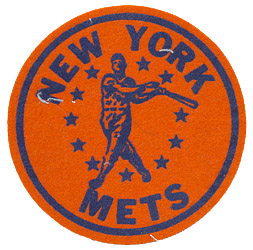 Where I grew up in Eastern Pennsylvania, most of the people were Philadelphia Phillies fans (or Yankees), but I followed the Mets on TV channel WOR-9 (broadcasting team of Bob Murphy, Lindsey Nelson and Ralph Kiner). The Mets were terrible for years after they joined the National League in 1962, setting all kinds of records for most games lost. But in 1969 they had put together a fantastic young pitching staff, headed by Tom Seaver, Gary Gentry, Jerry Koosman and Nolan Ryan. It is hard this many years later to separate what I actually watched on television at the time (or heard on the radio) with what I later saw on video or read about in books or online because the Mets 1969 season has taken on a kind of mythic character. The Mets were way behind the Chicago Cubs (8 or 9 games in August, and then 4 games in early September), but the Mets caught and passed the Cubs. The "Amazing" Mets became the great example of going from last place in one year to world champion the next.
Where I grew up in Eastern Pennsylvania, most of the people were Philadelphia Phillies fans (or Yankees), but I followed the Mets on TV channel WOR-9 (broadcasting team of Bob Murphy, Lindsey Nelson and Ralph Kiner). The Mets were terrible for years after they joined the National League in 1962, setting all kinds of records for most games lost. But in 1969 they had put together a fantastic young pitching staff, headed by Tom Seaver, Gary Gentry, Jerry Koosman and Nolan Ryan. It is hard this many years later to separate what I actually watched on television at the time (or heard on the radio) with what I later saw on video or read about in books or online because the Mets 1969 season has taken on a kind of mythic character. The Mets were way behind the Chicago Cubs (8 or 9 games in August, and then 4 games in early September), but the Mets caught and passed the Cubs. The "Amazing" Mets became the great example of going from last place in one year to world champion the next.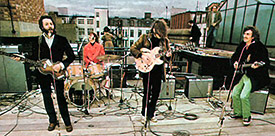 with the release of kind-of their last studio album, Let it Be. (Let's not get into technicalities on this.) Although there would be a lot of Beatles music released in the four decades after their break-up in 1970, Let it Be was really the end to their ten or so years of working together. John Lennon, Paul McCartney, George Harrison and Ringo Starr (a late replacement for Pete Best) began playing Liverpool, and then Hamburg, nightclubs in 1960. Their last live gig was the famous rooftop concert on top of the Apple Building in London on 30 January 1969, a pretty chilly day. The group's actual breakup could be dated to any day from 1969 onwards during the recording of their last real "collective" work, the Abbey Road album which was released 26 September 1969. On 10 April 1970 McCartney said in an interview that it was pretty clear that the Beatles had broken up, although there was as yet no official announcement since the Let It Be album had not yet been released.
with the release of kind-of their last studio album, Let it Be. (Let's not get into technicalities on this.) Although there would be a lot of Beatles music released in the four decades after their break-up in 1970, Let it Be was really the end to their ten or so years of working together. John Lennon, Paul McCartney, George Harrison and Ringo Starr (a late replacement for Pete Best) began playing Liverpool, and then Hamburg, nightclubs in 1960. Their last live gig was the famous rooftop concert on top of the Apple Building in London on 30 January 1969, a pretty chilly day. The group's actual breakup could be dated to any day from 1969 onwards during the recording of their last real "collective" work, the Abbey Road album which was released 26 September 1969. On 10 April 1970 McCartney said in an interview that it was pretty clear that the Beatles had broken up, although there was as yet no official announcement since the Let It Be album had not yet been released. This song actually came out much earlier (1965) than 1971, and it was a perfect song for stereo, with the opening lyrics alternating between the left and right tracks. Nowadays everyone takes for granted that music is recorded and played in stereo, but that was not always the case, and almost all of the hit songs of the 1950s and early 1960s were recorded and played in mono--the best examples of this involved Phil Spector's "wall of sound." Small transistor radios and most other radios, including car radios, played mono (one channel). I remember buying my first stereo that included a record player, a cassette player and two speakers from a store on 7th St. in Allentown in maybe 1971 or 1972. It must have cost a pretty penny for the combo, but for some reason I only realized what stereo actually sounded like when I heard the Mama and the Papas (Cass Elliot, Michelle Phillips, Denny Doherty, John Phillips) singing this song. As I noted, the opening lyrics alternate between the left and right speakers; and that's what stereo is all about. Pictured is my workhorse Technics SA-500 receiver from about 1978, still going very strong. Recently I even bought a back-up SA-500 on Ebay in case I need repair parts.
This song actually came out much earlier (1965) than 1971, and it was a perfect song for stereo, with the opening lyrics alternating between the left and right tracks. Nowadays everyone takes for granted that music is recorded and played in stereo, but that was not always the case, and almost all of the hit songs of the 1950s and early 1960s were recorded and played in mono--the best examples of this involved Phil Spector's "wall of sound." Small transistor radios and most other radios, including car radios, played mono (one channel). I remember buying my first stereo that included a record player, a cassette player and two speakers from a store on 7th St. in Allentown in maybe 1971 or 1972. It must have cost a pretty penny for the combo, but for some reason I only realized what stereo actually sounded like when I heard the Mama and the Papas (Cass Elliot, Michelle Phillips, Denny Doherty, John Phillips) singing this song. As I noted, the opening lyrics alternate between the left and right speakers; and that's what stereo is all about. Pictured is my workhorse Technics SA-500 receiver from about 1978, still going very strong. Recently I even bought a back-up SA-500 on Ebay in case I need repair parts.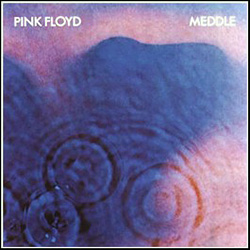 Let me cue it up on my computer. The rock album Meddle, released by Pink Floyd (David Gilmour, Nick Mason, Roger Waters, Rick Wright), was the
Let me cue it up on my computer. The rock album Meddle, released by Pink Floyd (David Gilmour, Nick Mason, Roger Waters, Rick Wright), was the  Just another old prom song by one of rock's greatest bands. This song goes back to roughly my high school years, along with other rock stalwarts such as the Moody Blues' Nights in White Satin, Jim Croce's Time in a Bottle, and Aerosmith's Dream On. The fourth album by the English rock band Led Zeppelin (Robert Plant, Jimmy Page, John Bonham and John Paul Jones) was released on 8 November 1971. No title is printed on the album, so it is usually referred to as Led Zeppelin IV, following the naming sequence used by the band's first three studio albums. It is also sometimes referred to as Zoso, but that's a long story. By the time that I was in college in the late 1970s, Zep was playing these enormous outdoor concert venues, such as Philadelphia's old JFK stadium which could hold in excess of 100,000 people (but not in very luxurious comfort). So I never really had a chance to see the band live in concert, but I also believed back then that it was hard for a band to play in front of such a large crowd, that somehow the music would sound like garbage and just wouldn't translate from the recording studio to the live stage. Could I have been more wrong about that with Zeppelin? Not sure. This is one of the greatest rock albums ever released, and it is doubtful that there has been a greater rock song than Stairway to Heaven. And it's not really even a rock song, more like a rock ballad, an epic poem
Just another old prom song by one of rock's greatest bands. This song goes back to roughly my high school years, along with other rock stalwarts such as the Moody Blues' Nights in White Satin, Jim Croce's Time in a Bottle, and Aerosmith's Dream On. The fourth album by the English rock band Led Zeppelin (Robert Plant, Jimmy Page, John Bonham and John Paul Jones) was released on 8 November 1971. No title is printed on the album, so it is usually referred to as Led Zeppelin IV, following the naming sequence used by the band's first three studio albums. It is also sometimes referred to as Zoso, but that's a long story. By the time that I was in college in the late 1970s, Zep was playing these enormous outdoor concert venues, such as Philadelphia's old JFK stadium which could hold in excess of 100,000 people (but not in very luxurious comfort). So I never really had a chance to see the band live in concert, but I also believed back then that it was hard for a band to play in front of such a large crowd, that somehow the music would sound like garbage and just wouldn't translate from the recording studio to the live stage. Could I have been more wrong about that with Zeppelin? Not sure. This is one of the greatest rock albums ever released, and it is doubtful that there has been a greater rock song than Stairway to Heaven. And it's not really even a rock song, more like a rock ballad, an epic poem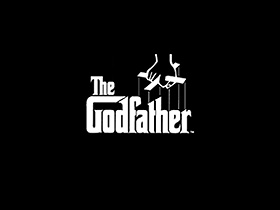 At first glance, it might appear surprising that a crime drama about a Sicilian mob family running their family business of murder and protection in New York in the United States would be an important movie about family values, but it is, and this is one of the great cinematic dramas. From the opening statement ("I believed in the promise of America."), and as the movie unrolls in an epic-ly long wedding scene (family), it reminds me of a contrast with Citizen Kane (above), which is also a movie dedicated to an American life. Those are two completely different interpretations of what it means to live an American life, yet both end tragically, and both leave you wondering what might have been different. The Godfather is based on the Mario Puzo novel of the same name, but in movie format it turned into a trilogy of movies about the rise and fall of a Sicilian family in America. All told, it is a very much romanticized tale of the business of the mafia and organized crime. Indeed, while there is some blood-letting in the movie (not going to mention the poor horse), there is not much business talk throughout, but there is a lot of talk about family. Francis Ford Coppola's movie with an all-star cast led by Marlon Brando received eleven Oscar nominations and won three.
At first glance, it might appear surprising that a crime drama about a Sicilian mob family running their family business of murder and protection in New York in the United States would be an important movie about family values, but it is, and this is one of the great cinematic dramas. From the opening statement ("I believed in the promise of America."), and as the movie unrolls in an epic-ly long wedding scene (family), it reminds me of a contrast with Citizen Kane (above), which is also a movie dedicated to an American life. Those are two completely different interpretations of what it means to live an American life, yet both end tragically, and both leave you wondering what might have been different. The Godfather is based on the Mario Puzo novel of the same name, but in movie format it turned into a trilogy of movies about the rise and fall of a Sicilian family in America. All told, it is a very much romanticized tale of the business of the mafia and organized crime. Indeed, while there is some blood-letting in the movie (not going to mention the poor horse), there is not much business talk throughout, but there is a lot of talk about family. Francis Ford Coppola's movie with an all-star cast led by Marlon Brando received eleven Oscar nominations and won three.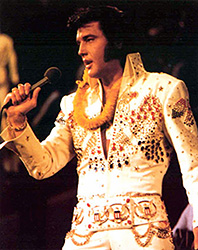
 A small news item appeared on the front page of the Morning Call newspaper back in 1973. Yes, Jim Croce had died, the creator of such songs as Time in a Bottle, Operator, You Don't Mess around with Jim, Bad Bad Leroy Brown, was gone. His death brought to an end a strain of folk music in American rock, the folk tradition of Pete Seeger, Arlo Guthrie, Peter, Paul and Mary, early Bob Dylan. I think that it was a very long time until it semi-re-emerged in American pop music, maybe with Suzanne Vega. Croce's death in a place crash bore a kind of eerie semblance to another plane crash a decade and a half previously, the day the music died. Croce was a talented song-writer and had just begun to enjoy considerable success with his 1972 and 1973 albums--while I usually have record albums of 1970s rock musicians, in this case I only have cassette tapes.
A small news item appeared on the front page of the Morning Call newspaper back in 1973. Yes, Jim Croce had died, the creator of such songs as Time in a Bottle, Operator, You Don't Mess around with Jim, Bad Bad Leroy Brown, was gone. His death brought to an end a strain of folk music in American rock, the folk tradition of Pete Seeger, Arlo Guthrie, Peter, Paul and Mary, early Bob Dylan. I think that it was a very long time until it semi-re-emerged in American pop music, maybe with Suzanne Vega. Croce's death in a place crash bore a kind of eerie semblance to another plane crash a decade and a half previously, the day the music died. Croce was a talented song-writer and had just begun to enjoy considerable success with his 1972 and 1973 albums--while I usually have record albums of 1970s rock musicians, in this case I only have cassette tapes. I had never heard of this work of "philosophical fiction" with autobiographical overtones until I came across this battered paperback in the early 1980s when I was just starting grad school. Robert Pirsig (1928-) was a really smart guy that struggled with formal education and that experienced a psychological breakdown and electro shock therapy--thankfully we don't do that anymore. Since it has been a while since I last read the book, and since I knew the entire premise of the book is the search for "quality" (and a lot of that search takes place in the depths of classical Greek philosophy). OK, let me restart a new sentence. What I remember most of all about the book was the quest for an understanding of quality, and how that quest should define everything that you do in your life. Now, I went to see what
I had never heard of this work of "philosophical fiction" with autobiographical overtones until I came across this battered paperback in the early 1980s when I was just starting grad school. Robert Pirsig (1928-) was a really smart guy that struggled with formal education and that experienced a psychological breakdown and electro shock therapy--thankfully we don't do that anymore. Since it has been a while since I last read the book, and since I knew the entire premise of the book is the search for "quality" (and a lot of that search takes place in the depths of classical Greek philosophy). OK, let me restart a new sentence. What I remember most of all about the book was the quest for an understanding of quality, and how that quest should define everything that you do in your life. Now, I went to see what  Well, not quite. Sometime in the fall of 1974 (could have been the spring of 1975) everyone in my high school filed into the school auditorium for an assembly. That was not an unusual event; we had assemblies, concerts, shows, awards gatherings and pep rallies there all the time. I have no idea what the occasion was this time, but it might have been some kind of talent show. At some point, all the teachers started leaving, and the back doors were closed. Up on stage I noticed a rock band that proceeded to launch into an ear-deafening cover of Deep Purple's Smoke on the Water (1972)--
Well, not quite. Sometime in the fall of 1974 (could have been the spring of 1975) everyone in my high school filed into the school auditorium for an assembly. That was not an unusual event; we had assemblies, concerts, shows, awards gatherings and pep rallies there all the time. I have no idea what the occasion was this time, but it might have been some kind of talent show. At some point, all the teachers started leaving, and the back doors were closed. Up on stage I noticed a rock band that proceeded to launch into an ear-deafening cover of Deep Purple's Smoke on the Water (1972)--
 A little pile of rice on the floor and grains of rice flying through the night air, a water squirt gun, some newspapers covering heads, I can't even remember what else was required in terms of props for the audience performances accompanying the showing of the Rocky Horror Picture Show at the midnight movies on Saturday nights in the 1970s. The movie introduced a new kind of cultural experience, performance movie watching. Rocky Horror also made midnight movies a "big" thing. Midnight movies had existed before. I recall seeing Let It Be, as a late night movie, and Clockwork Orange, and Easy Rider, but Rocky Horror broke all kinds of new ground with the props and the audience participation along with the movie. It made for a lot of fun. And BTW, let's not forget that the soundtrack to the movie is outstanding; in some respects, better than the movie itself. And if you don't know, the movie is loosely based around a crazy doctor who is trying to create a new man from parts of dead men (sounds vaguely familiar).
A little pile of rice on the floor and grains of rice flying through the night air, a water squirt gun, some newspapers covering heads, I can't even remember what else was required in terms of props for the audience performances accompanying the showing of the Rocky Horror Picture Show at the midnight movies on Saturday nights in the 1970s. The movie introduced a new kind of cultural experience, performance movie watching. Rocky Horror also made midnight movies a "big" thing. Midnight movies had existed before. I recall seeing Let It Be, as a late night movie, and Clockwork Orange, and Easy Rider, but Rocky Horror broke all kinds of new ground with the props and the audience participation along with the movie. It made for a lot of fun. And BTW, let's not forget that the soundtrack to the movie is outstanding; in some respects, better than the movie itself. And if you don't know, the movie is loosely based around a crazy doctor who is trying to create a new man from parts of dead men (sounds vaguely familiar).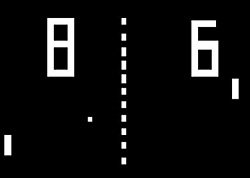
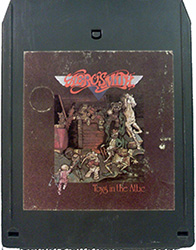 Toys in the Attic by Aerosmith, boy, does that take the mind way back to the days when 8-track tapes were the cutting-edge music technology--now they have long been relegated to the dustbin of history. 8-tracks were supplanted by cassette tapes, and then CDs, then DVS, and now no tapes, just download and play some mp3 files. The 8-tracks had a weird kind of continuous tape winding system so that the tape never really came to an end. To have a really "cool" car back then meant that you had to have an under-dash-mounted 8-track tape player, and a pile of tapes laying on your front seat. There were very few of my friends who had a car with that kind of setup. I remember trading for the Toys in the Attic tape, maybe it was the Beatles red album that I traded. This was probably Aerosmith's best studio album.
Toys in the Attic by Aerosmith, boy, does that take the mind way back to the days when 8-track tapes were the cutting-edge music technology--now they have long been relegated to the dustbin of history. 8-tracks were supplanted by cassette tapes, and then CDs, then DVS, and now no tapes, just download and play some mp3 files. The 8-tracks had a weird kind of continuous tape winding system so that the tape never really came to an end. To have a really "cool" car back then meant that you had to have an under-dash-mounted 8-track tape player, and a pile of tapes laying on your front seat. There were very few of my friends who had a car with that kind of setup. I remember trading for the Toys in the Attic tape, maybe it was the Beatles red album that I traded. This was probably Aerosmith's best studio album.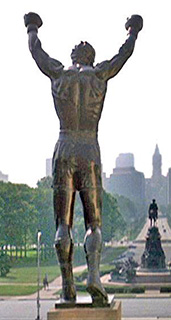
 With this album, interest in all things having to do with Jamaica, and especially reggae music, exploded on the pop culture scene. Similar to what the Blues Brothers did for interest in blues music with their movie and soundtrack The Blues Brothers (1980)--see below--Bob Marley (1945-1981) and the Wailers, did for reggae. There was actually not all that much of a demand for reggae music before this album, but by the end of the 1970s reggae had become enormously popular. This was actually the band's ninth studio album, and it made Bob Marley an international star, although he did not live very long to capitalize on his fame. While I am not necessarily a big reggae fan, I do remember buying the album when it came out because of the airplay that I heard on FM radio. I think that one of the Marleys is still alive and performing today.
With this album, interest in all things having to do with Jamaica, and especially reggae music, exploded on the pop culture scene. Similar to what the Blues Brothers did for interest in blues music with their movie and soundtrack The Blues Brothers (1980)--see below--Bob Marley (1945-1981) and the Wailers, did for reggae. There was actually not all that much of a demand for reggae music before this album, but by the end of the 1970s reggae had become enormously popular. This was actually the band's ninth studio album, and it made Bob Marley an international star, although he did not live very long to capitalize on his fame. While I am not necessarily a big reggae fan, I do remember buying the album when it came out because of the airplay that I heard on FM radio. I think that one of the Marleys is still alive and performing today.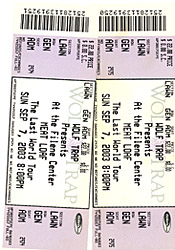 This rock opera (a collaboration of composer Jim Steinman and singer Meatloaf aka Michael Lee Aday) is one of the best selling albums in rock history, and so perfectly captured the flavor of teenage life in the 1970s. One after another the tracks rolled off the vinyl and into rock history. Having played this album easily more than thousands of times now, the lyrics are etched into my memory. The album is so brilliantly crafted in the studio (thanks to Steinman and Todd Rundgren), I don't think that it ever took well to the live stage. Many years later, we finally got to a Meatloaf concert. By this time, Bat Out of Hell II and Bat Out of Hell III had been released (along with a lot of other bad Meatloaf music). Had to leave the concert early; it was just so bad. The Meat just did not have it anymore. Probably best to leave it at the fact that the Meatloaf was a one hit wonder, but what a rich wonder. Interesting to note that his first real break came when he appeared in the Rocky Horror Picture Show (also above on the list).
This rock opera (a collaboration of composer Jim Steinman and singer Meatloaf aka Michael Lee Aday) is one of the best selling albums in rock history, and so perfectly captured the flavor of teenage life in the 1970s. One after another the tracks rolled off the vinyl and into rock history. Having played this album easily more than thousands of times now, the lyrics are etched into my memory. The album is so brilliantly crafted in the studio (thanks to Steinman and Todd Rundgren), I don't think that it ever took well to the live stage. Many years later, we finally got to a Meatloaf concert. By this time, Bat Out of Hell II and Bat Out of Hell III had been released (along with a lot of other bad Meatloaf music). Had to leave the concert early; it was just so bad. The Meat just did not have it anymore. Probably best to leave it at the fact that the Meatloaf was a one hit wonder, but what a rich wonder. Interesting to note that his first real break came when he appeared in the Rocky Horror Picture Show (also above on the list).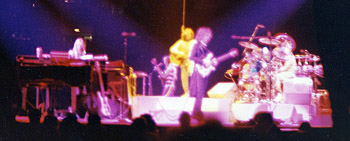 The late part of the 1970s was a weird time for music. On one hand, you had a lot of disco magic going on, and that could really drive people who liked rock crazy. The disco craze would have been artists like Donna Summer, The Village People, the Bee Gees and others. The worst of it all was the Bee Gee's album soundtrack for Saturday Night Fever (40 million copies sold). But there were some small signs, possibly in the punk world, that all was not lost. There was a new punk scene emerging, such as centered on the Sex Pistols and around CBGB's in New York. But somewhere in between was Nick Lowe's Pure Pop for Now People (1978), a fun album that poked a lot of fun at the pop music world. I might mention two other important artists of this time were Elvis Costello and the Attractions (Oliver's Army) and Blondie (Slow Motion).
The late part of the 1970s was a weird time for music. On one hand, you had a lot of disco magic going on, and that could really drive people who liked rock crazy. The disco craze would have been artists like Donna Summer, The Village People, the Bee Gees and others. The worst of it all was the Bee Gee's album soundtrack for Saturday Night Fever (40 million copies sold). But there were some small signs, possibly in the punk world, that all was not lost. There was a new punk scene emerging, such as centered on the Sex Pistols and around CBGB's in New York. But somewhere in between was Nick Lowe's Pure Pop for Now People (1978), a fun album that poked a lot of fun at the pop music world. I might mention two other important artists of this time were Elvis Costello and the Attractions (Oliver's Army) and Blondie (Slow Motion). It's an image from The Man Who Shot Liberty Valence with Jimmy Stewart. You've got to wonder who was nutty enough to put him thirteenth on the list of great actors of the silver screen; he should have been at least top 5! Marion Mitchell Morrison (1907-1979) grew up in California (a talented football player) and became one of the movie industry's biggest stars of the 1940s and 1950s, when he cranked out the movies (over 150 of them). In the 1930s he appeared in dozens of "B" class western, shoot em up movies, but his big break came with John Ford's Stagecoach (1939), and then his American war hero movies: Sands of Iwo Jima (1949), Flying Tigers (1942), The Fighting Seabees (1944), They Were Expendable (1945), Flying Leathernecks (1951). Then there was Wayne's starring roles in John Ford's cavalry trilogy: Fort Apache (1948), She Wore a Yellow Ribbon (1949), Rio Grande (1950). Two of his more renowned roles were in the Quiet Man (1952) and The Searchers (1956). And let's not forget The Man Who Shot Liberty Valence (1962) and North to Alaska (1960). Finally, True Grit (1969) won him an academy award that was long over due--and why even bother to remake that movie! His last film was The Shootist (1976). We are not going to mention that in 1956 he dared to play Genghis Khan in a terrible film called The Conqueror.
It's an image from The Man Who Shot Liberty Valence with Jimmy Stewart. You've got to wonder who was nutty enough to put him thirteenth on the list of great actors of the silver screen; he should have been at least top 5! Marion Mitchell Morrison (1907-1979) grew up in California (a talented football player) and became one of the movie industry's biggest stars of the 1940s and 1950s, when he cranked out the movies (over 150 of them). In the 1930s he appeared in dozens of "B" class western, shoot em up movies, but his big break came with John Ford's Stagecoach (1939), and then his American war hero movies: Sands of Iwo Jima (1949), Flying Tigers (1942), The Fighting Seabees (1944), They Were Expendable (1945), Flying Leathernecks (1951). Then there was Wayne's starring roles in John Ford's cavalry trilogy: Fort Apache (1948), She Wore a Yellow Ribbon (1949), Rio Grande (1950). Two of his more renowned roles were in the Quiet Man (1952) and The Searchers (1956). And let's not forget The Man Who Shot Liberty Valence (1962) and North to Alaska (1960). Finally, True Grit (1969) won him an academy award that was long over due--and why even bother to remake that movie! His last film was The Shootist (1976). We are not going to mention that in 1956 he dared to play Genghis Khan in a terrible film called The Conqueror. By the end of the 1970s, about five years after the United States had left the conflict in Vietnam, and after the fall of South Vietnam, film-makers had begun to explore the Vietnam experience in a series of emotionally-charged movies: The Deer Hunter, 1978 (5 Oscars) directed by Michael Cimino; Apocalypse Now, 1979 (2 Oscars) directed by Francis Ford Coppola; Platoon, 1986 (4 Oscars) directed by Oliver Stone; and Full Metal Jacket, 1987 directed by Stanley Kubrik. The Vietnam War had been a tragic event for American society (52,286 dead), and, in one way or another, each of these movies captured an aspect of the futility, if I can use that term, of the American involvement in the war. Roget Ebert wrote of The Deer Hunter, "It is a progression from a wedding to a funeral," and, I guess, that the Deer Hunter has always been the most reminiscent for me of a Pennsylvania setting. Apocalypse Now tells the story of a journey up a river in Vietnam into madness (Joseph Conrad's Heart of Darkness), and was one of Marlon Brando's last major film roles. Brando was allegedly very difficult to work with, but look at some of his other movie roles: On the Waterfront, The Godfather, A Streetcar Named Desire, Ultimo tango a Parigi.
By the end of the 1970s, about five years after the United States had left the conflict in Vietnam, and after the fall of South Vietnam, film-makers had begun to explore the Vietnam experience in a series of emotionally-charged movies: The Deer Hunter, 1978 (5 Oscars) directed by Michael Cimino; Apocalypse Now, 1979 (2 Oscars) directed by Francis Ford Coppola; Platoon, 1986 (4 Oscars) directed by Oliver Stone; and Full Metal Jacket, 1987 directed by Stanley Kubrik. The Vietnam War had been a tragic event for American society (52,286 dead), and, in one way or another, each of these movies captured an aspect of the futility, if I can use that term, of the American involvement in the war. Roget Ebert wrote of The Deer Hunter, "It is a progression from a wedding to a funeral," and, I guess, that the Deer Hunter has always been the most reminiscent for me of a Pennsylvania setting. Apocalypse Now tells the story of a journey up a river in Vietnam into madness (Joseph Conrad's Heart of Darkness), and was one of Marlon Brando's last major film roles. Brando was allegedly very difficult to work with, but look at some of his other movie roles: On the Waterfront, The Godfather, A Streetcar Named Desire, Ultimo tango a Parigi.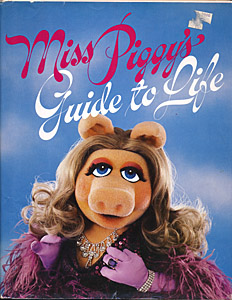 I can no longer recall when I first saw this movie back in 79 or 80, but I have seen it countless times since then--mostly on my VHS player--and I still marvel at what a great accomplishment it was to convince the Muppets to perform on the big screen (and with all the cameo appearances from Hollywood stars thrown in there too). I was a big Muppet Show fan when it ran on television from 1976 to 1981. Part of this time, I was in college, and I looked forward to the weekly show and the guest stars. It still seems strange to me that Jim Henson (1936-1990) had to have a production company in England to make the show. The show's "pigs in space" segment was always especially funny. For a long time now, I have considered Jim Henson to have been one of the artistic geniuses of the twentieth century for what he was able to do with a sock puppet and a sawn-in-half ping pong ball (and thus creating Kermit the Frog) and then the rest of the Muppets. Henson's Muppets had appeared on Sesame Street since 1969, they had their own television show (and some specials); and they created three very popular Hollywood movies. What unbelievable puppets! Look, there are not a whole lot of successful, full-length Hollywood movies out there that star puppets (think about that). The opening seen of
I can no longer recall when I first saw this movie back in 79 or 80, but I have seen it countless times since then--mostly on my VHS player--and I still marvel at what a great accomplishment it was to convince the Muppets to perform on the big screen (and with all the cameo appearances from Hollywood stars thrown in there too). I was a big Muppet Show fan when it ran on television from 1976 to 1981. Part of this time, I was in college, and I looked forward to the weekly show and the guest stars. It still seems strange to me that Jim Henson (1936-1990) had to have a production company in England to make the show. The show's "pigs in space" segment was always especially funny. For a long time now, I have considered Jim Henson to have been one of the artistic geniuses of the twentieth century for what he was able to do with a sock puppet and a sawn-in-half ping pong ball (and thus creating Kermit the Frog) and then the rest of the Muppets. Henson's Muppets had appeared on Sesame Street since 1969, they had their own television show (and some specials); and they created three very popular Hollywood movies. What unbelievable puppets! Look, there are not a whole lot of successful, full-length Hollywood movies out there that star puppets (think about that). The opening seen of  It is now 2013, and the Sony Walkman that I bought in about 1986 still works and plays cassette tapes fine--I still have a Bruce Springsteen tape in there, Born to Run and Darkness on the Edge of Town. The radio also works fine on this vintage remnant of once cutting-edge technology; the headphones have deteriorated and been replaced. In the 1980s, this was the height of music fashion and advanced technology. Can you imagine, how great it was to have personal, portable music? The cassette version, like mine, eventually went out of fashion in the mid-1990s, but mine got a lot of hard use, especially as I sat for hours typing in one of UVa's computer labs. Check out what wiki notes, "The original Walkman introduced a change in music listening habits by allowing people to carry music with them and listen to music through lightweight headphones."
It is now 2013, and the Sony Walkman that I bought in about 1986 still works and plays cassette tapes fine--I still have a Bruce Springsteen tape in there, Born to Run and Darkness on the Edge of Town. The radio also works fine on this vintage remnant of once cutting-edge technology; the headphones have deteriorated and been replaced. In the 1980s, this was the height of music fashion and advanced technology. Can you imagine, how great it was to have personal, portable music? The cassette version, like mine, eventually went out of fashion in the mid-1990s, but mine got a lot of hard use, especially as I sat for hours typing in one of UVa's computer labs. Check out what wiki notes, "The original Walkman introduced a change in music listening habits by allowing people to carry music with them and listen to music through lightweight headphones."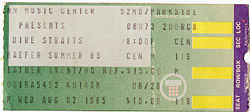 One of the great concept albums of all times was created by this British rock group (sometimes labeled as part of the progressive wave). Once you have listened to the songs on the album, you will begin to make out the bigger allusions at work. This is one of my favorite albums of all time, right up there with Supertramp's Even in the Quietest Moments, Mary Hopkin's Postcard, Genesis' A Trick of the Tail, Springsteen's Born to Run, and so on. Mark Knopfler founded Dire Straits in 1977 with his brother David, who actually left the group during the recording of Making Movies--the band itself finally called it quits in 1995. Their hit single from 1978, Sultans of Swing, brought them fame and got them a gig as the opening band for Talking Heads (see below) on a worldwide tour. After Making Movies, Dire Straits followed with other great albums like Telegraph Road and Brothers in Arms. I saw the band on their 1985 tour after the Brothers in Arms album. It was a strange concert as most of the audience did not seem to know the music or was confused about how to react to the music. My sister and her friends got in trouble with the police for dancing in the aisles while everyone was yelling at them to get out of the way. People were yelling at us to sit down throughout the show. Dire Straits also did an incredible set at Live Aid (1984). See below.
One of the great concept albums of all times was created by this British rock group (sometimes labeled as part of the progressive wave). Once you have listened to the songs on the album, you will begin to make out the bigger allusions at work. This is one of my favorite albums of all time, right up there with Supertramp's Even in the Quietest Moments, Mary Hopkin's Postcard, Genesis' A Trick of the Tail, Springsteen's Born to Run, and so on. Mark Knopfler founded Dire Straits in 1977 with his brother David, who actually left the group during the recording of Making Movies--the band itself finally called it quits in 1995. Their hit single from 1978, Sultans of Swing, brought them fame and got them a gig as the opening band for Talking Heads (see below) on a worldwide tour. After Making Movies, Dire Straits followed with other great albums like Telegraph Road and Brothers in Arms. I saw the band on their 1985 tour after the Brothers in Arms album. It was a strange concert as most of the audience did not seem to know the music or was confused about how to react to the music. My sister and her friends got in trouble with the police for dancing in the aisles while everyone was yelling at them to get out of the way. People were yelling at us to sit down throughout the show. Dire Straits also did an incredible set at Live Aid (1984). See below.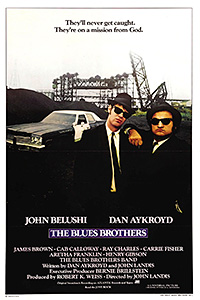
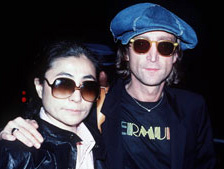
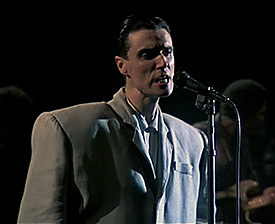
 This weird little book appeared at the start of the 1980s as a humorous counterpoise to the age of quiche-eating, thoughtful, troubled men, and other individuals, who were having trouble defining the qualities of a man. (See the next item on the list.) On the one hand, the book is a lot of satirical fun; on the other hand, there is some pretty, darned good information in there... There are chapters providing tongue-in-cheek wisdom on such varied subjects as The Real Man's Nutritional Guide, The Real Man's Film Festival, Great Moments in Real Man History, Black Dates in Real Man's History. Probably the best part of the book is the Real Man's television viewing schedule with programs listed such as football, baseball, Dragnet, Kojak, Mannix, Star Trek, Gunsmoke, S.W.A.T., Hawaii Five-O, Columbo, The Rifleman, Bonanza, Hill Street Blues, Sgt. Bilko, Hogan's Heroes, Maverick, Cannon, Rat Patrol (a personal favorite of all of us kids when we were little), The Rockford Files. As you can see, the list is heavy on westerns and detective shows from the 60s and 70s. All in all, it is really a pretty good guidebook.
This weird little book appeared at the start of the 1980s as a humorous counterpoise to the age of quiche-eating, thoughtful, troubled men, and other individuals, who were having trouble defining the qualities of a man. (See the next item on the list.) On the one hand, the book is a lot of satirical fun; on the other hand, there is some pretty, darned good information in there... There are chapters providing tongue-in-cheek wisdom on such varied subjects as The Real Man's Nutritional Guide, The Real Man's Film Festival, Great Moments in Real Man History, Black Dates in Real Man's History. Probably the best part of the book is the Real Man's television viewing schedule with programs listed such as football, baseball, Dragnet, Kojak, Mannix, Star Trek, Gunsmoke, S.W.A.T., Hawaii Five-O, Columbo, The Rifleman, Bonanza, Hill Street Blues, Sgt. Bilko, Hogan's Heroes, Maverick, Cannon, Rat Patrol (a personal favorite of all of us kids when we were little), The Rockford Files. As you can see, the list is heavy on westerns and detective shows from the 60s and 70s. All in all, it is really a pretty good guidebook. Some might find this to be a strange choice for a cultural event of the late twentieth century, but here it is. Boy George (George Alan O'Dowd, 1961-) and his band Culture Club released this album in 1983, and it ended up making not only a lot of airplay (on FM radio and on MTV) but also a created a lot of controversy--BTW, it sold over ten million copies. Boy George was certainly a strange character, breaking new ground in the fashion world with his misogynist dress and appearance and breaking new ground in the sexual world with his ambiguous sexual orientation--and the album still sold millions of copies showing that sexual mores were changing rapidly in the 1980s. He did eventually clear up the fact that he was gay. There is some really great music on the album, including
Some might find this to be a strange choice for a cultural event of the late twentieth century, but here it is. Boy George (George Alan O'Dowd, 1961-) and his band Culture Club released this album in 1983, and it ended up making not only a lot of airplay (on FM radio and on MTV) but also a created a lot of controversy--BTW, it sold over ten million copies. Boy George was certainly a strange character, breaking new ground in the fashion world with his misogynist dress and appearance and breaking new ground in the sexual world with his ambiguous sexual orientation--and the album still sold millions of copies showing that sexual mores were changing rapidly in the 1980s. He did eventually clear up the fact that he was gay. There is some really great music on the album, including 
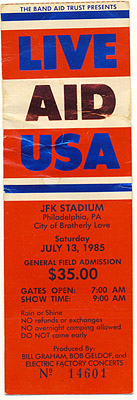 The setting: Wembley Stadium London (over seventy thousand people) and John F. Kennedy Stadium in Philadelphia (over one hundred thousand people)--note that the old Wembley Stadium, built 1923, has since been demolished and replaced; JFK Stadium, built 1926, has also been demolished and replaced. The temperature in Philadelphia had to have been well over 100° on the field amidst that mass of people, no clouds that day.
The setting: Wembley Stadium London (over seventy thousand people) and John F. Kennedy Stadium in Philadelphia (over one hundred thousand people)--note that the old Wembley Stadium, built 1923, has since been demolished and replaced; JFK Stadium, built 1926, has also been demolished and replaced. The temperature in Philadelphia had to have been well over 100° on the field amidst that mass of people, no clouds that day. Star Trek: The Next Generation ran on television from 1987 to 1994, many years after the original Star Trek series first aired on TV from 1966 to 1969--I'm sure that you can still watch the reruns of any of the Start Trek series somewhere on either cable television or online. With this series Gene Roddenberry, originator of the entire Star Trek franchise, including the movies, probably created his ideal image of a captain and crew, their devotion to duty and to one another, and their bravery. This Captain Picard, Geordi Laforge, Data, and Worf (often mistakenly called "woof" by certain fans of the show who had trouble pronouncing the "r" sound). This critically-acclaimed show was much see TV, along with Seinfeld, for years and launched a bunch of sequels, Star Trek Deep Space 9 (1993-1999), Star Trek: Voyager (1995-2001) and then Star Trek: Enterprise (2001-2005).
Star Trek: The Next Generation ran on television from 1987 to 1994, many years after the original Star Trek series first aired on TV from 1966 to 1969--I'm sure that you can still watch the reruns of any of the Start Trek series somewhere on either cable television or online. With this series Gene Roddenberry, originator of the entire Star Trek franchise, including the movies, probably created his ideal image of a captain and crew, their devotion to duty and to one another, and their bravery. This Captain Picard, Geordi Laforge, Data, and Worf (often mistakenly called "woof" by certain fans of the show who had trouble pronouncing the "r" sound). This critically-acclaimed show was much see TV, along with Seinfeld, for years and launched a bunch of sequels, Star Trek Deep Space 9 (1993-1999), Star Trek: Voyager (1995-2001) and then Star Trek: Enterprise (2001-2005). In reality, it was difficult to decide on an exact date for this item. I first encountered this novel by Mikhail Bulgakov (1891-1940) when I was in grad school at the University of Virginia. What an amazingly bizarre, fantastic work. I have also always loved Bulgakov's Heart of a Dog (Собачье сердце, 1925), and I think that was how I "discovered" Bulgakov.
In reality, it was difficult to decide on an exact date for this item. I first encountered this novel by Mikhail Bulgakov (1891-1940) when I was in grad school at the University of Virginia. What an amazingly bizarre, fantastic work. I have also always loved Bulgakov's Heart of a Dog (Собачье сердце, 1925), and I think that was how I "discovered" Bulgakov.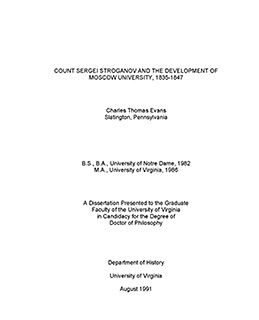 Silent Lucidity is a fantastic single by Queensrÿche from the 1990 album Empire. I'd call it a typical one-hit wonder, but the group is still around and releasing albums. The song appeared while I was in the midst of writing my dissertation and received an awful lot of airtime on the radio. The dissertation work required heavy duty concentration, and so I would often listen to the radio on my Sony Walkman while I was typing away in one of the campus computer labs. I still think that this is one of the greatest songs of the last fifty years, and I still always connect it with the work on
Silent Lucidity is a fantastic single by Queensrÿche from the 1990 album Empire. I'd call it a typical one-hit wonder, but the group is still around and releasing albums. The song appeared while I was in the midst of writing my dissertation and received an awful lot of airtime on the radio. The dissertation work required heavy duty concentration, and so I would often listen to the radio on my Sony Walkman while I was typing away in one of the campus computer labs. I still think that this is one of the greatest songs of the last fifty years, and I still always connect it with the work on 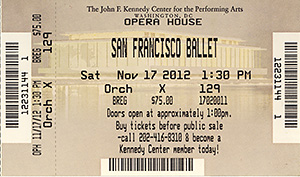 Of course, I am just kidding about the debut date. Sergei Prokofiev (1891-1953)--he died the same day as Stalin; so you know who got all the publicity; they even had a hard time just having his funeral--completed this ballet way back in 1935, and it first premiered in Czechoslovakia in 1938. There are a number of different versions out there now, and it remains one of the most popular ballets performed today. The music is simply fantastic.
Of course, I am just kidding about the debut date. Sergei Prokofiev (1891-1953)--he died the same day as Stalin; so you know who got all the publicity; they even had a hard time just having his funeral--completed this ballet way back in 1935, and it first premiered in Czechoslovakia in 1938. There are a number of different versions out there now, and it remains one of the most popular ballets performed today. The music is simply fantastic.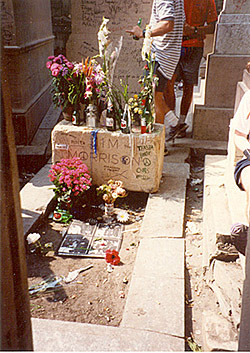 This (Jim Morrison's grave in Père Lachaise Cemetery in Paris) was, and hopefully still is, one of the essential pilgrimage place in the world for all lovers of rock music. When we visited Paris, we did not go to the Louvre, nor to Notre Dame Cathedral, but we did find our way to Morrison's grave site.
This (Jim Morrison's grave in Père Lachaise Cemetery in Paris) was, and hopefully still is, one of the essential pilgrimage place in the world for all lovers of rock music. When we visited Paris, we did not go to the Louvre, nor to Notre Dame Cathedral, but we did find our way to Morrison's grave site. Seems light years ago when the DOS--a whole new generation has grown up without ever having to learn DOS commands--version of this PC strategy game first appeared. The computer game revolution was just underway, and that revolution would lead to a whole new form of entertainment based on computer games initially, and then later the PlayStation, X-box, Wii machines and the whole set of handheld game devices. I think that you would be hard-pressed to find a kid today who hasn't played video games.
Seems light years ago when the DOS--a whole new generation has grown up without ever having to learn DOS commands--version of this PC strategy game first appeared. The computer game revolution was just underway, and that revolution would lead to a whole new form of entertainment based on computer games initially, and then later the PlayStation, X-box, Wii machines and the whole set of handheld game devices. I think that you would be hard-pressed to find a kid today who hasn't played video games. It was a cold, frosty morning for President Clinton's inauguration when Maya Angelou approached the microphone. I had never heard of her and was leery of what she was going to say. She was the second poet to speak at a presidential inauguration (Robert Frost had read his poem "The Gift Outright" at President Kennedy's chilly inauguration on 20 January 1961), and the first black woman to do so. She began her poem, "
It was a cold, frosty morning for President Clinton's inauguration when Maya Angelou approached the microphone. I had never heard of her and was leery of what she was going to say. She was the second poet to speak at a presidential inauguration (Robert Frost had read his poem "The Gift Outright" at President Kennedy's chilly inauguration on 20 January 1961), and the first black woman to do so. She began her poem, "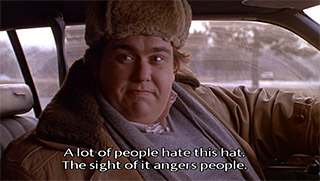
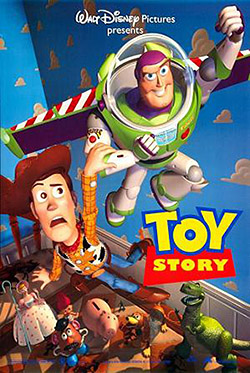
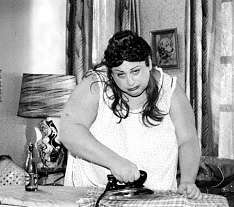 I think that I first came upon this movie sometime in 1997, or it could have been a few years earlier or later. It has become one of my most watched films and is simply a great, fun movie with a bizarre cast: Divine, Sonny Bono, Debbie Harry (of Blondie fame), Riki Lake, Jerry Stiller, Mink Stole, Ric Ocasek, etc. Has there been a more bizarre American drag queen actor of the past decades than Divine (1945-88)? You might also ask if there has been a more bizarre director than John Waters? He has produced some pretty crazy stuff. This movie came out in 1988 and has since spawned a musical version and then a stupid remake in 2007. (I do not consider the remake to be a viable cultural production.) Although the movie kind of addressed the widespread racism of the early 1960s, the real fun part of the movie is the satirical absurdities throughout--the rat and moon reflection in the puddle of water--(and the great music--buy the soundtrack). If you can't smile while watching the opening scene with its music and everyone spraying tons of hairspray into their hair, then there might be something wrong with you. It is fun, a fun movie;
I think that I first came upon this movie sometime in 1997, or it could have been a few years earlier or later. It has become one of my most watched films and is simply a great, fun movie with a bizarre cast: Divine, Sonny Bono, Debbie Harry (of Blondie fame), Riki Lake, Jerry Stiller, Mink Stole, Ric Ocasek, etc. Has there been a more bizarre American drag queen actor of the past decades than Divine (1945-88)? You might also ask if there has been a more bizarre director than John Waters? He has produced some pretty crazy stuff. This movie came out in 1988 and has since spawned a musical version and then a stupid remake in 2007. (I do not consider the remake to be a viable cultural production.) Although the movie kind of addressed the widespread racism of the early 1960s, the real fun part of the movie is the satirical absurdities throughout--the rat and moon reflection in the puddle of water--(and the great music--buy the soundtrack). If you can't smile while watching the opening scene with its music and everyone spraying tons of hairspray into their hair, then there might be something wrong with you. It is fun, a fun movie; 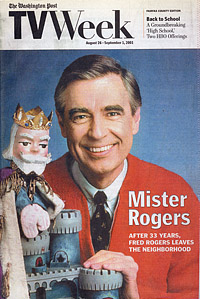 The last episodes of Mister Rogers' Neighborhood aired on PBS stations across the country. Mr. McFeely's handshake with Fred Rogers (1928-2003) at the end of the episode was the only sign that it was the last show. Airing on public television since 1968, the children's show lasted over thirty years, probably close to one thousand shows. Before starting this particular show, Rogers had been involved with children's shows since the early 1950s (first as a puppeteer). Over the years, Rogers covered all kinds of different topics, speaking softly and clearly to his kid audience. His shows always had great jazz music in the background and often included some kind of explanatory video about how something was made. My favorites were about brass musical instruments and Crayola crayons. He also frequently had guests appear on the show to talk about their work or art. While I always thought the land of make-believe was a little weird, I certainly understood Fred's point for children to be able to make the distinction between reality and fantasy. He was an immensely talented artist. One should also consider that the 1970s and 1980s were not all that kind to the city of Pittsburgh except for the Steelers of the 70s, the Pirates of 79 and Mister Rogers' Neighborhood.
The last episodes of Mister Rogers' Neighborhood aired on PBS stations across the country. Mr. McFeely's handshake with Fred Rogers (1928-2003) at the end of the episode was the only sign that it was the last show. Airing on public television since 1968, the children's show lasted over thirty years, probably close to one thousand shows. Before starting this particular show, Rogers had been involved with children's shows since the early 1950s (first as a puppeteer). Over the years, Rogers covered all kinds of different topics, speaking softly and clearly to his kid audience. His shows always had great jazz music in the background and often included some kind of explanatory video about how something was made. My favorites were about brass musical instruments and Crayola crayons. He also frequently had guests appear on the show to talk about their work or art. While I always thought the land of make-believe was a little weird, I certainly understood Fred's point for children to be able to make the distinction between reality and fantasy. He was an immensely talented artist. One should also consider that the 1970s and 1980s were not all that kind to the city of Pittsburgh except for the Steelers of the 70s, the Pirates of 79 and Mister Rogers' Neighborhood. Somewhere around 2005, I finally got around to watching Laputa: Castle in the Sky (aka Laputa or Castle in the Sky or 天空の城ラピュタ or Tenkū no Shiro Rapyuta, 1986), a film written and directed by Hayao Miyazaki (1941-). This was the Disney release of 2003 that generated a lot of controversy among critics and "those-in-the-know" over the dubbing and some minor changes in the original film to fit the US market--there was also criticism over the later US versions of Miyazaki's movies Spirited Away and Princess Mononoke. Whatever the case, the Miyazaki productions are magnificent films and easily as brilliant as some of the productions of Walt Disney. Castle in the Sky also reminded me--although in different ways--of two other more recent path-breaking films such as The Muppet Movie or Who Framed Roger Rabbit–well, not that recent!
Somewhere around 2005, I finally got around to watching Laputa: Castle in the Sky (aka Laputa or Castle in the Sky or 天空の城ラピュタ or Tenkū no Shiro Rapyuta, 1986), a film written and directed by Hayao Miyazaki (1941-). This was the Disney release of 2003 that generated a lot of controversy among critics and "those-in-the-know" over the dubbing and some minor changes in the original film to fit the US market--there was also criticism over the later US versions of Miyazaki's movies Spirited Away and Princess Mononoke. Whatever the case, the Miyazaki productions are magnificent films and easily as brilliant as some of the productions of Walt Disney. Castle in the Sky also reminded me--although in different ways--of two other more recent path-breaking films such as The Muppet Movie or Who Framed Roger Rabbit–well, not that recent! 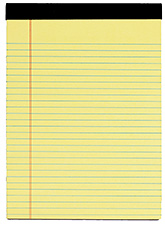 Apple's innovative tablet device went on sale in the United States in April 2010 and was quickly recognized as a bringing a new kind of Internet experience to its users. Now the iPad was not the first tablet device to appear on the market. Indeed, Microsoft had experimented with a tablet computer, but the Apple's touch screen, convenient size (maybe 5" by 10" by 1") and relatively user-friendly interface to online social media made the iPad enormously popular (despite its rather high price). Supposedly, Apple sold more than three million in the first three months of its availability. The first generation iPad was followed by a second generation and then a third generation version in March 2012. Now everyone has an Ipad, including real little kids; and the things are everywhere, at soccer games, swim meets, libraries, cooking demonstrations, concerts, kitchens, bedrooms, cars, etc. Elementary and high schools are considering making them mandatory devices for kids. Colleges are experimenting with new ways of teaching that make use of the Ipad. The devices are certainly reshaping the computing experiences for millions and millions of users.
Apple's innovative tablet device went on sale in the United States in April 2010 and was quickly recognized as a bringing a new kind of Internet experience to its users. Now the iPad was not the first tablet device to appear on the market. Indeed, Microsoft had experimented with a tablet computer, but the Apple's touch screen, convenient size (maybe 5" by 10" by 1") and relatively user-friendly interface to online social media made the iPad enormously popular (despite its rather high price). Supposedly, Apple sold more than three million in the first three months of its availability. The first generation iPad was followed by a second generation and then a third generation version in March 2012. Now everyone has an Ipad, including real little kids; and the things are everywhere, at soccer games, swim meets, libraries, cooking demonstrations, concerts, kitchens, bedrooms, cars, etc. Elementary and high schools are considering making them mandatory devices for kids. Colleges are experimenting with new ways of teaching that make use of the Ipad. The devices are certainly reshaping the computing experiences for millions and millions of users.